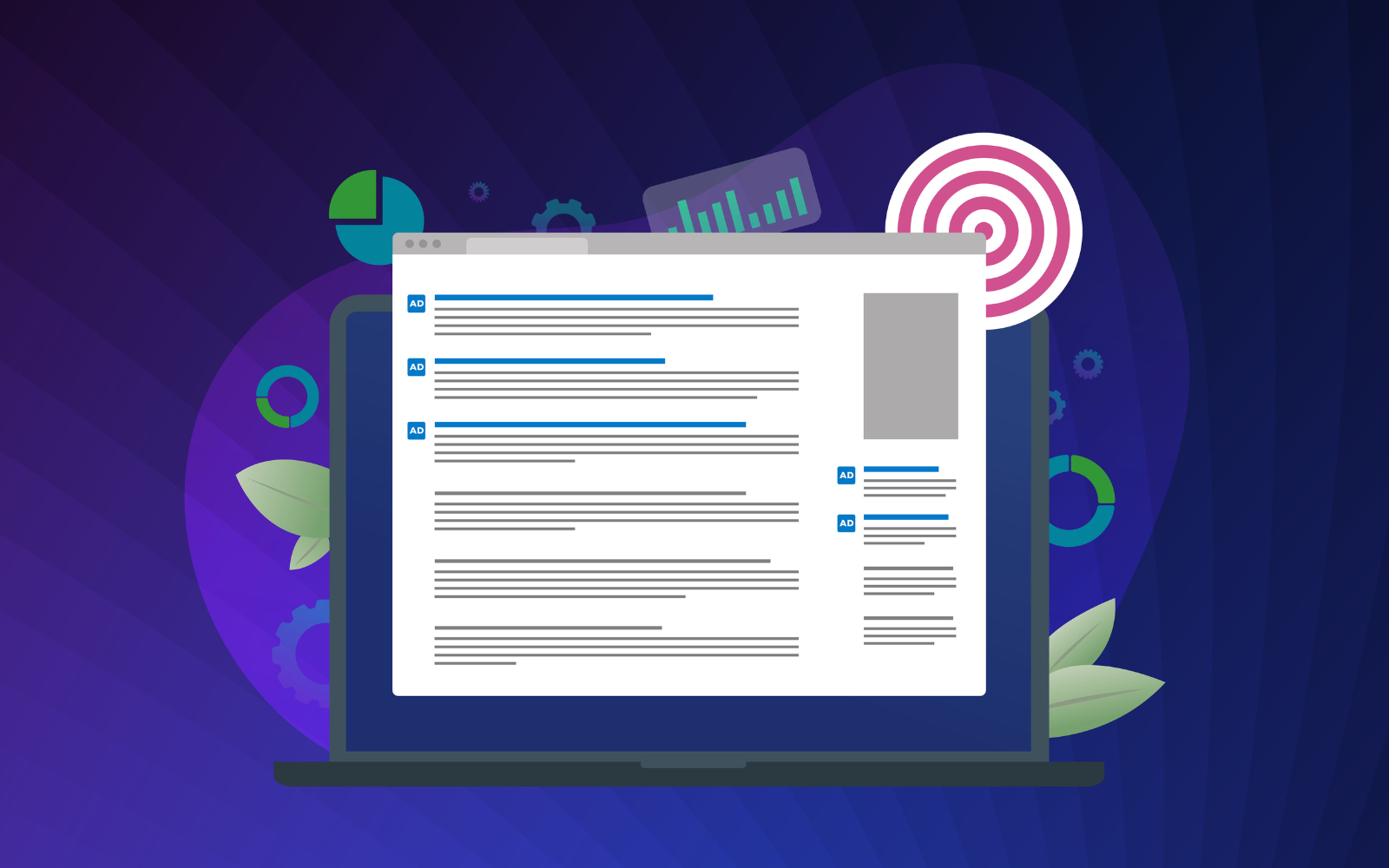If you’re not using Google Ads, this could be the wake-up call your business needs.
Google Ads is the most widely used digital marketing platform, bringing in over $58 billion in ad revenue in Q2 alone.
Google also owns just under 92% of the search engine market share globally, processing over 8.5 billion searches each day.
This in-depth guide covers the ins and outs of the Google Ads platform, leaving you with the tools, techniques, and best practices to achieve optimal digital marketing results.
What Is Google Ads?
Google Ads is an online advertising platform that allows advertisers to pay for ad space on Google-owned properties.
The platform has been around since October 2000 and was formerly known as Google AdWords.
Since its conception, the advertising platform has evolved and expanded its offerings. It officially rebranded to Google Ads in July 2018.
Google Ads is a great way for companies to increase visibility to potential customers across its vast array of the Google network.
The most common form of Google Ads is a Search ad, which shows up on the search engine results page (SERP) when users search relevant products and searches of the advertiser.
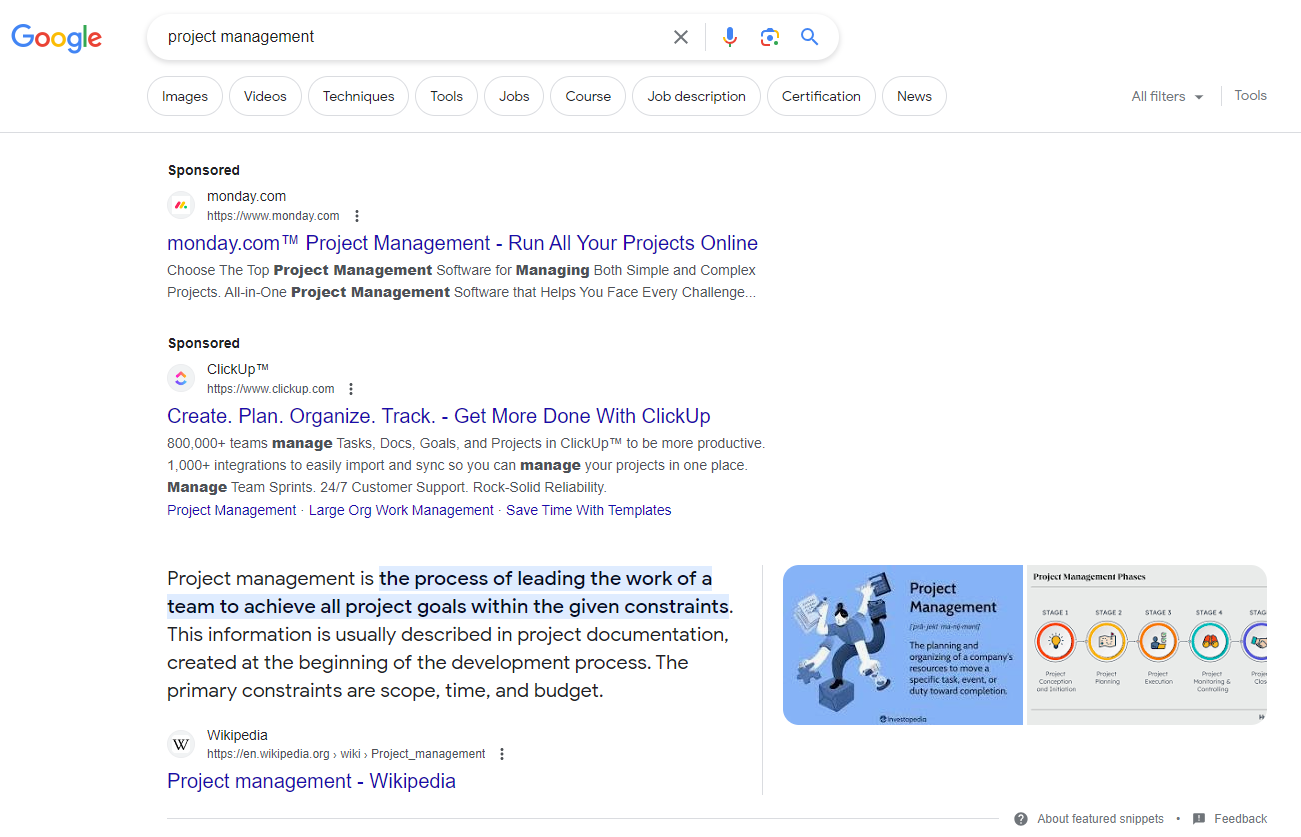 Screenshot from search for [project management], Google, September 2023
Screenshot from search for [project management], Google, September 2023However, bidding on keywords doesn’t always mean that your ad will show above an organic result, let alone at the top of the page.
While Google Search ads are the most common, companies rely on its other products like Display ads, Shopping ads, YouTube ads, and more – depending on their goals.
Speaking of goals, let’s discuss who should use Google Ads.
[PPC Trends 2024] Download the free ebook →
When Should I Use Google Ads?
Google Ads can be used for a wide range of business objectives and goals.
If your company is looking to meet any of these objectives, it’s worth exploring the potential of Google Ads further.
- Starting a new business. Google Ads provides the opportunity to get in front of new audiences quickly, especially when launching a new business. Since organic traffic typically takes time with new content, Google Ads helps you reach potential customers faster.
- Increase lead generation. If your business relies on lead generation, such as collecting email addresses or contact information, Google Ads can help you reach users interested in your products or services and direct them to lead-generation forms on your website.
- Boosting sales and revenue. For e-commerce brands, Google Ads can be a powerful tool to drive sales. From Search to Shopping to Video, your ads can showcase products directly in search results or while a user is browsing the internet.
- Promoting time-sensitive content. If you have time-sensitive promotions, events, or sales, Google Ads can help you get the word out quickly and effectively to a targeted audience.
- Reach new audiences. Google Ads provides a myriad of targeting options, allowing you to reach specific demographics, interests, geographic locations, and more. This can be especially beneficial for niche markets.
- Win back website visitors. If you want to re-engage users who have previously visited your website but didn’t convert, remarketing campaigns can remind them of your products or services and encourage them to return.
Get the picture yet?
Google Ads can be used for almost any business goal or objective out there.
With many different campaign types to choose from, the platform can be effective in helping reach those overarching business goals.
How Does Google Ads Work?
Before diving into how Google Ads works, it’s important to give context on who is involved in the art of advertising.
There are three key participants involved in a Google Ad auction:
- The consumer/searcher.
- The advertiser.
- The advertising platform.
Google Ads primarily uses a “cost-per-click” (CPC) model for most campaigns.
For campaigns with a primary goal of awareness, the typical cost model used is “cost-per-mille” (CPM). This equates to how much an advertiser pays per 1,000 impressions.
This means that advertisers bid on specific keywords to ensure their ad shows up to users who are searching those keywords.
But because it is a bidding model, advertisers are also competing with other brands for that coveted ad space.
In a CPC model, an advertiser’s bids are considered a “maximum bid” – essentially, how much you’re willing to pay per click for someone to click on your ad and hopefully purchase.
When a user searches for a keyword that matches what an advertiser has bid on, their ad will show to that potential customer.
During the user’s Google search, Google Ads performs a real-time auction to determine what advertisers’ ads should show to that particular user. Many factors play into the ad order on the SERP, which we’ll get into later.
To summarize how Google Ads work, an advertiser has to know what keywords they should bid on in their campaigns. Those targeted keywords then inform Google Ads when and how their ads should appear to a user.
And finally, there has to be enough user interest for those targeted keywords for an ad to appear.
Google Ads Basic Terms
Now that you’ve got a basic understanding of how the Google Ads auction works, let’s go over a few necessary basic terms.
Make sure to study and familiarize yourself with them.
This section will cover the following definitions:
- Ad assets (formerly “extensions”).
- Ad Rank.
- Bidding strategy.
- Campaign type.
- Click-through-rate (CTR).
- Conversion rate.
- Impression.
- Keywords.
- Landing page.
- Quality Score.
- Targeting.
Ad assets
Ad assets enable advertisers to include additional content to complement a search ad. If an ad asset is clicked, it would be at the same cost-per-click (CPC) as the ad itself.
Ad assets currently available in Google Ads include:
- Sitelinks.
- Call.
- Location.
- Callout.
- Structured snippets.
- Price.
- App.
- Lead forms.
Ad Rank
Ad Rank is a metric created by Google Ads. It’s a value that determines your ad’s position in any given auction, or whether your ad will show at all.
Google determines Ad Rank by calculating numerous factors, such as your bid amount, real-time ad quality, competition, and more.
Ad Rank is covered in more detail in the next section.
Bidding Strategy
A bidding strategy is set at the campaign level in Google Ads.
Simply put, a bidding strategy is a set of rules and parameters, defined by the advertiser, to help determine the optimal cost per action on ads.
Google offers many different bidding types to choose from based on the campaign goal.
At a high level, bidding strategies are clustered into three main categories:
- Conversion-based bidding. Also known as Smart Bidding, Google provides numerous strategies to take into consideration any conversion goals such as CPA or ROAS.
- Click-based bidding. These bid strategies are typically chosen if the campaign goal is focused on generating website traffic.
- Reach-based bidding. Different bid strategies are available if the campaign’s primary objective is brand awareness.
Keep reading to learn the ins and outs of bidding strategy types further in this article.
Campaign Type
When creating a new Google Ads campaign, a campaign type needs to be chosen.
The campaign type determines:
- What Google inventory an ad can show on.
- What ad formats and assets are available.
- What type of targeting is available.
Be sure to check out the types of Google Ads campaigns section for further details.
Click-Through Rate (CTR)
Click-through rate (CTR) is another key Google Ads metric.
To calculate CTR, simply take the number of clicks received on an ad divided by the number of impressions.
Different campaign types yield different CTR benchmarks, mainly due to differences in ad position, where the ad is shown, ad format, and more.
For example, a Search ad typically reports a higher CTR than a Display ad because the intent is greater on Search, whereas Display is more passive in nature.
Conversion Rate
Conversion rate measures the volume of primary actions (conversions) against the number of clicks on an ad.
Conversion actions could include a purchase, website form submission, subscription signup, and much more.
A high conversion rate usually means the ad was relevant to the user, as well as the content presented on the website page, which led to that ultimate purchase.
Impression
In simple terms, an impression is counted every time an ad is shown on Google.
Sometimes impressions are referred to as “eyeballs” on an ad.
The impression metric is used when calculating CTR and is useful when analyzing low CTR scenarios.
Keep in mind that one user can account for multiple impressions – meaning a user can see the same ad more than once – so impressions do not equate to the amount of unique “eyeballs” on ads.
Keyword
A keyword is a word or phrase advertisers choose to bid on in Search campaigns.
When choosing keywords to bid on, it’s important to select phrases that align with what your target customer is looking for.
There are three types of keyword match types to choose from in Google Ads:
- Broad match.
- Phrase match.
- Exact match.
On the other side, negative keywords consist of terms that you don’t want your ads to show for.
When implemented properly, Google will make sure that your ad won’t appear if a user searches for a phrase within your negative keyword list.
Negative keyword lists can be added at the ad group, campaign, or account level.
Landing Page
A landing page is where a user will land (no pun intended) on your website after clicking an ad.
When creating a landing page, it’s important to make sure that the website experience delivers on the ad promise.
If the landing page doesn’t match what’s presented in the ad, you’ve essentially wasted marketing dollars due to a poor user experience.
Quality Score
The Quality Score metric measures – you guessed it – the quality of your ad.
It’s made of measuring three components and presented with a score ranging from 1 to 10:
- Expected CTR.
- Ad relevance.
- Landing page experience.
Read more in the next section on Ad Rank for a full picture of Quality Score.
Targeting
Google provides many options to narrow down who to show your ad to.
This is referred to as targeting: choosing specific criteria to define and reach a particular audience.
Depending on the campaign type, Google allows these types of audience targeting:
- Location targeting.
- Demographic targeting.
- Interest-based targeting.
- Device targeting.
- Ad schedule targeting.
- Retargeting.
- Placement targeting.
- Contextual targeting.
- Custom or combination targeting.
Effective targeting is crucial to ensure your ads reach the intended audience and achieve campaign goals.
[Recommended Read] → PPC Trends 2024
How Much Do Google Ads Cost?
While there are plenty of benchmark resources out there for reference, the best answer is this:
It depends.
There are multiple factors to consider how much Google Ads cost. The main ones include:
- Your average daily budget.
- Ad Rank.
Let’s look at each of these a little further.
Average Daily Budget
The maximum daily budget is determined by the advertiser and is set at the campaign level.
But, if you work in Google Ads, you’ll see that the daily budget is not followed to the letter by Google.
Per Google’s definition of spending limits, it determines cost by:
- A daily spending limit (no more than 2x your average daily budget).
- A monthly spending limit (no more than 30.4x your average daily budget).
So, campaign spend can sometimes look like this.
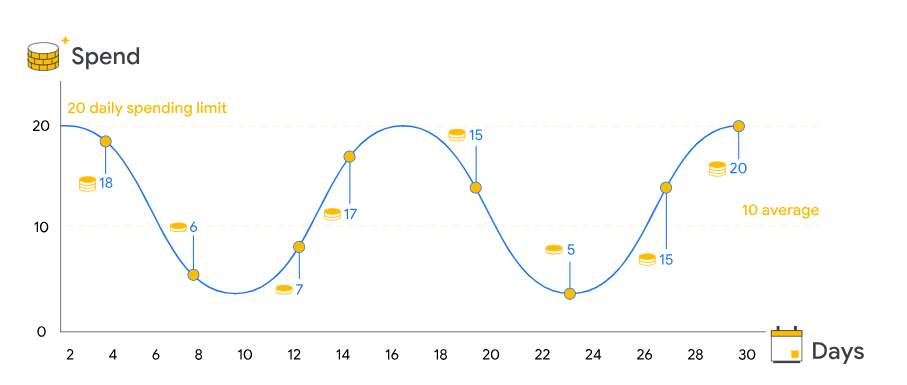 Image from support.google.com, September 2023
Image from support.google.com, September 2023It’s critical to set an average daily budget high enough to meet the campaign goals, as well as the business goals.
It’s also important to do your research on average CPCs in your industry before setting a daily budget.
For example, if your industry is competitive, where average CPCs could range between $20-$30, a daily budget of $50 will not cut it. In fact, your ads likely won’t show as much because the algorithm’s learning is restricted.
Ad Rank
One of the primary factors that affects how much Google Ads cost is the Ad Rank metric.
Ad Rank is a value assigned to each individual ad by Google, which determines the ad position on the search engine results page.
Remember, when your ad is entered into an auction, Google compares your Ad Rank to other advertisers bidding on that same keyword.
It’s not enough to set a big daily budget and massive CPC limits.
While CPC bids are one facet of Ad Rank, there are others to consider. The main components that make up ad rank are:
- Bid amount.
- Quality Score/ad quality (expected CTR, ad relevance, landing page experience).
- Ad Rank thresholds.
- Competitiveness of auction.
- Context of a user’s search.
Now, there are items within Ad Rank that you can and cannot influence.
Advertisers are not in control over the auction competition nor the context of a user search. Additionally, since the Ad Rank threshold is dynamic and made up of other advertisers, it’s not something marketers can directly influence.
The most important factors marketers should pay attention to when it comes to optimizing Google Ads cost are the bid amount and ad quality.
- Bid amount. This is the amount you are willing to pay to show up in a specific position when a user searches a keyword. There are the minimum and maximum thresholds. For example, if you set a maximum CPC of $2 and the next highest bidder has a max CPC of $1.60, you would then pay $1.61 in that auction.
- Expected CTR. The likelihood that your ad will be clicked on by a potential customer during the ad auction. Google doesn’t provide much context on determining what that likelihood is, unfortunately.
- Ad relevance. How closely your ad copy and assets match the user’s search query intent.
- Landing page experience. How relevant or useful the landing page is to the user who clicked on the ad.
Focusing on improving these aspects of a campaign can positively affect the cost efficiency of your Google Ads campaigns.
Types Of Google Ads
Google’s advertising platform provides marketers with numerous digital ad types to use, making it a platform useful for almost any brand.
The following campaign types are available:
- Search campaigns.
- Display campaigns.
- Shopping campaigns.
- Video campaigns.
- App campaigns.
- Performance Max campaigns.
- Demand Gen campaigns.
Within those campaigns live the following ad types:
- Text ads.
- Responsive ads.
- Image ads.
- App promotion ads.
- Video ads.
- Shopping ads.
- Call-only ads.
Because ad formats can be used in different campaign types, let’s focus on the Google Ads campaign types a bit further.
Search Campaigns
If you’ve been paying attention, the main focus up until now has been on Search ads.
Search campaigns use the text ad format, more specifically, a Responsive Search ad, that appears on the search engine results page for a particular keyword.
While the primary ad is text-based, marketers can utilize countless ad assets to complement the ad. Some popular ad assets used are image assets, price promotions, and sitelinks.
For example, here is a search ad result for the keyword “standing desk.”
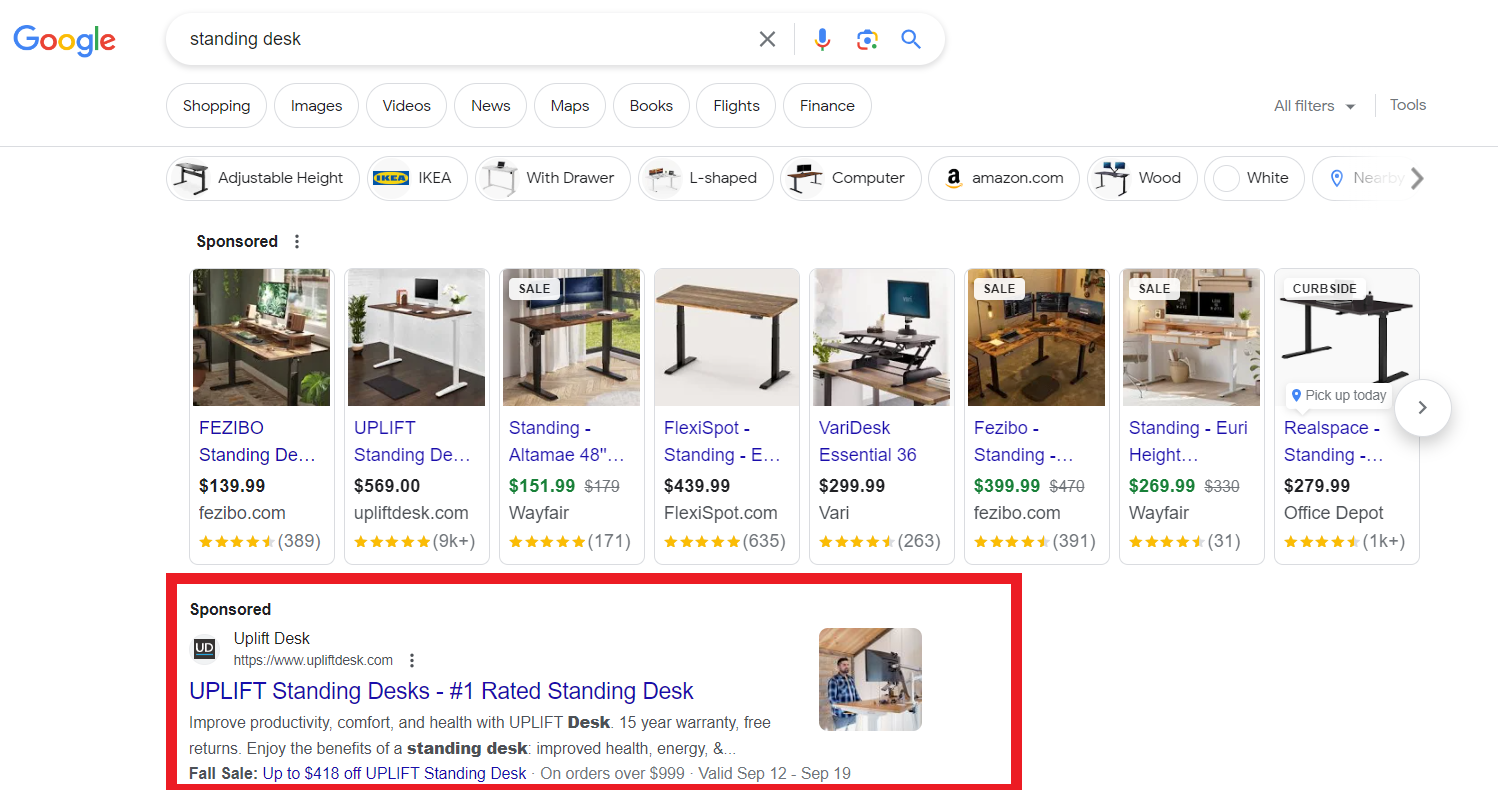 Screenshot from search for [standing desk], Google, September 2023
Screenshot from search for [standing desk], Google, September 2023This example uses image assets, which help give the user more visuals of the product to help encourage a click. The advertiser also utilizes additional ad assets like promotions.
As you can see from the example, other ad types appear for this particular search, even above the text ad. Those are known as Shopping campaigns.
Shopping Campaigns
Shopping campaigns let brands promote products more visually and not just on the search results page.
Going back to the “standing desk” example, A shopping campaign ad is made up primarily of the product title, description, price, and product image.
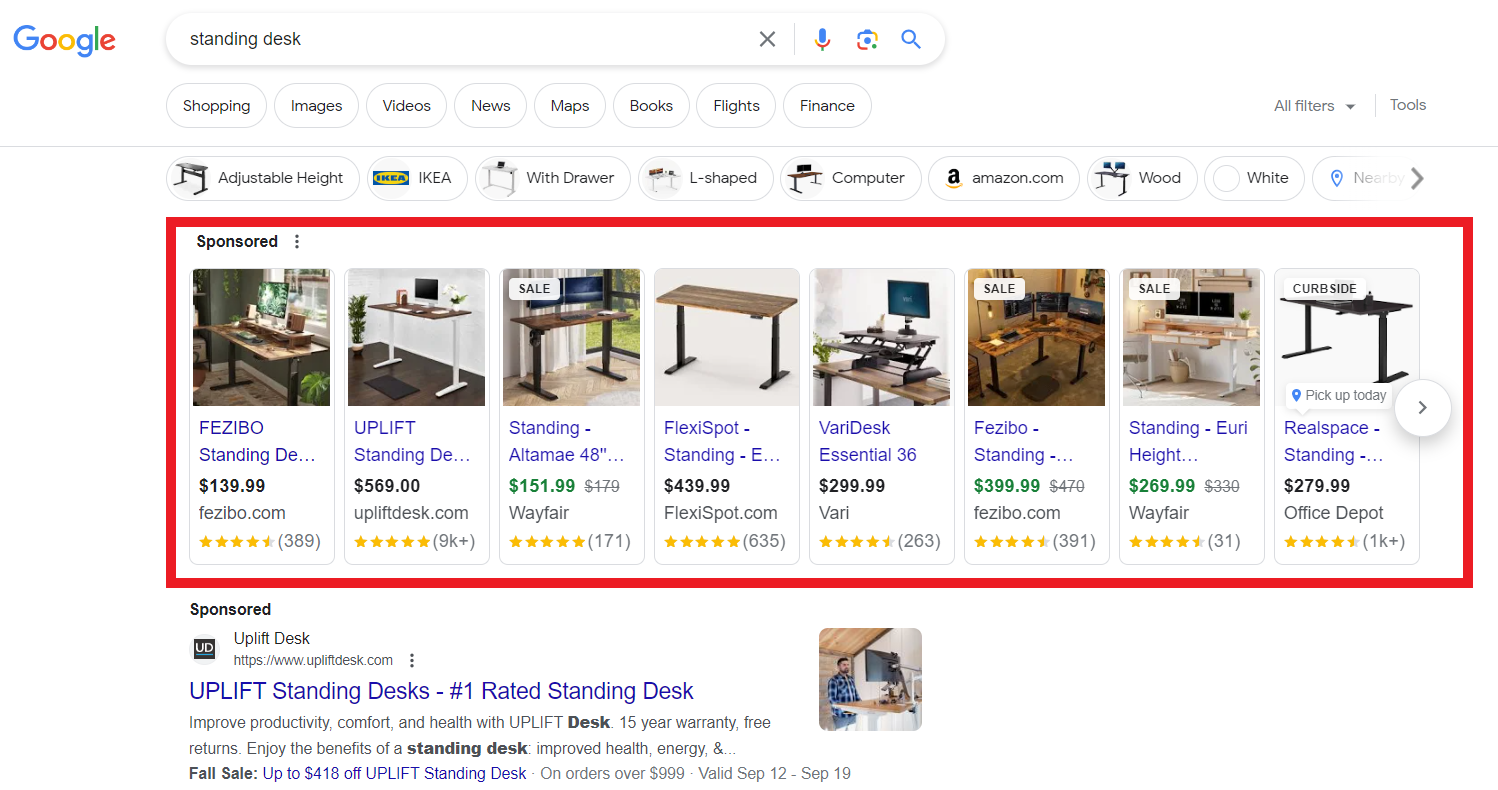 Screenshot from search for [standing desk], Google, September 2023
Screenshot from search for [standing desk], Google, September 2023There are many more available fields within a product feed that can and should be used to ensure your products are represented in the most accurate way.
Shopping ads can show up on the following Google properties:
- Search results page.
- Shopping tab.
- Google images.
- Google Search Network partner websites.
- And more if utilizing Performance Max campaigns.
Display Campaigns
Display campaigns typically use a combination of image and text assets that are shown on web pages or apps within the Google Display Network.
The primary ad format used is the Responsive Display ad. As mentioned above, a Responsive Display ad takes a combination of headlines, descriptions, images, brand logos, or videos to mix and match the ideal ad format for each user.
Display campaigns are ideal for users who want to extend reach to their target audience, or to retarget interested users into re-engaging with them and purchasing.
Google allows advertisers to target (or exclude) specific website categories, apps, or individual placements.
Additionally, Google has recently allowed Display ads to show up on YouTube. This is important to review, especially if you plan on running YouTube ads in conjunction with Display ads to mitigate any potential overlap.
In the example below, a Display ad is shown on the right-hand side of the Good Housekeeping website as I was scrolling the homepage:
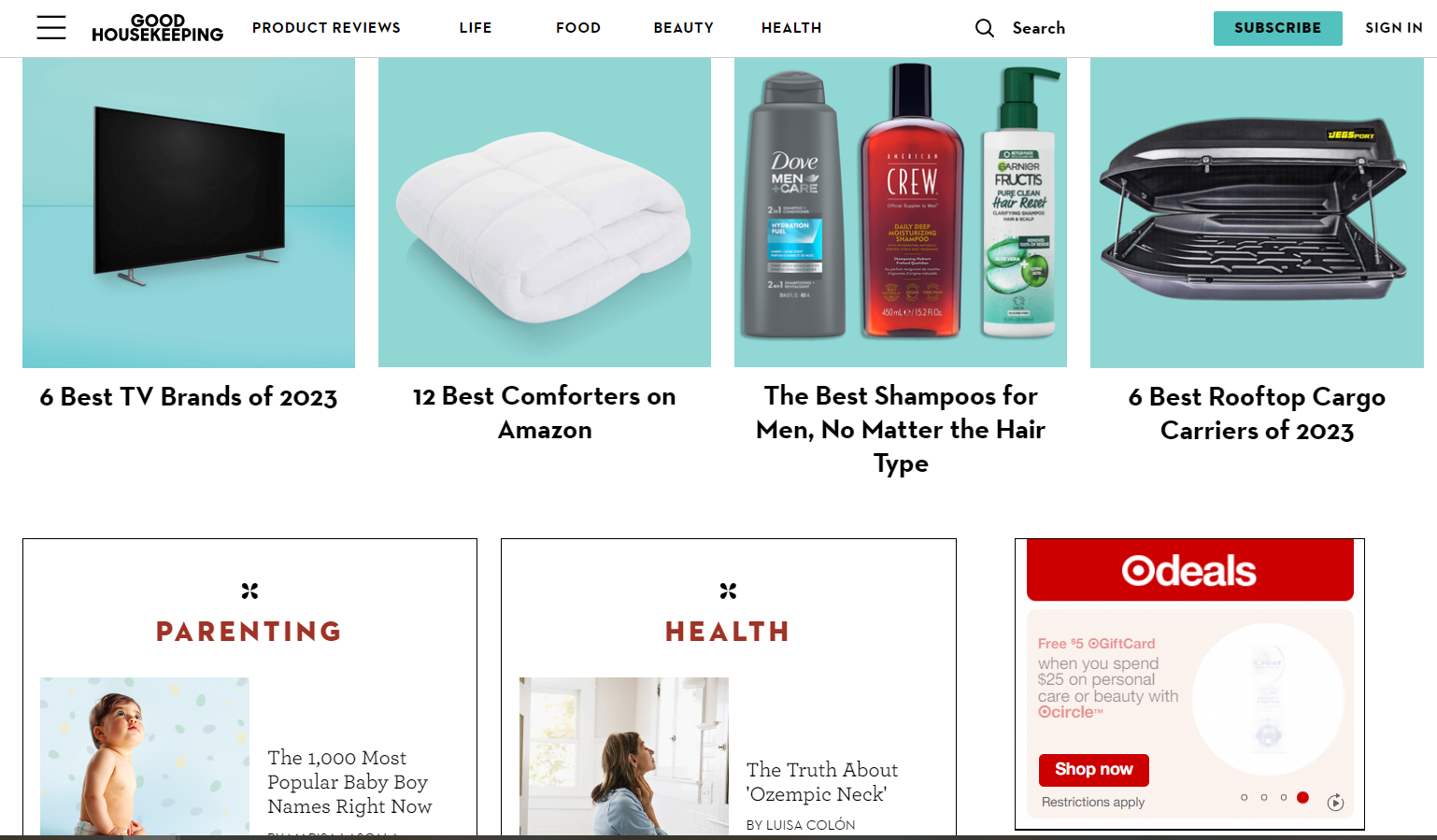 Screenshot from Good Housekeeping, September 2023
Screenshot from Good Housekeeping, September 2023Video Campaigns
Video campaigns allow advertisers to show ads not only on YouTube but also on Google video partner websites and apps.
YouTube provides massive, scalable reach to your targeted audience.
If you’re looking to only showcase ads on YouTube, make sure to disable the Google video partners within campaign settings.
There are multiple video ad formats available to choose from based on your goals:
- Skippable in-stream ads. These ads play either before, during, or after other videos on YouTube. Users have the option to skip the ad after five seconds.
- Non-skippable in-stream ads. Since these ads are non-skippable, the video length maxes out at 15 seconds.
- Bumper ads. This is a short video format, comprising only six seconds or less. Users aren’t able to skip these ads. They’re designed to increase awareness and reach users more broadly.
- In-feed video ads. This ad format only shows on YouTube. The appearance of this particular ad varies based on the ad sizes and format that content publishers support. They appear in areas where users are discovering content. After a viewer clicks on the ad thumbnail, they’re taken to either the brand’s YouTube watch or channel page.
- Outstream ads. This ad format only appears on Google video partner websites and apps, not on YouTube. They’re only available on mobile and tablet devices.
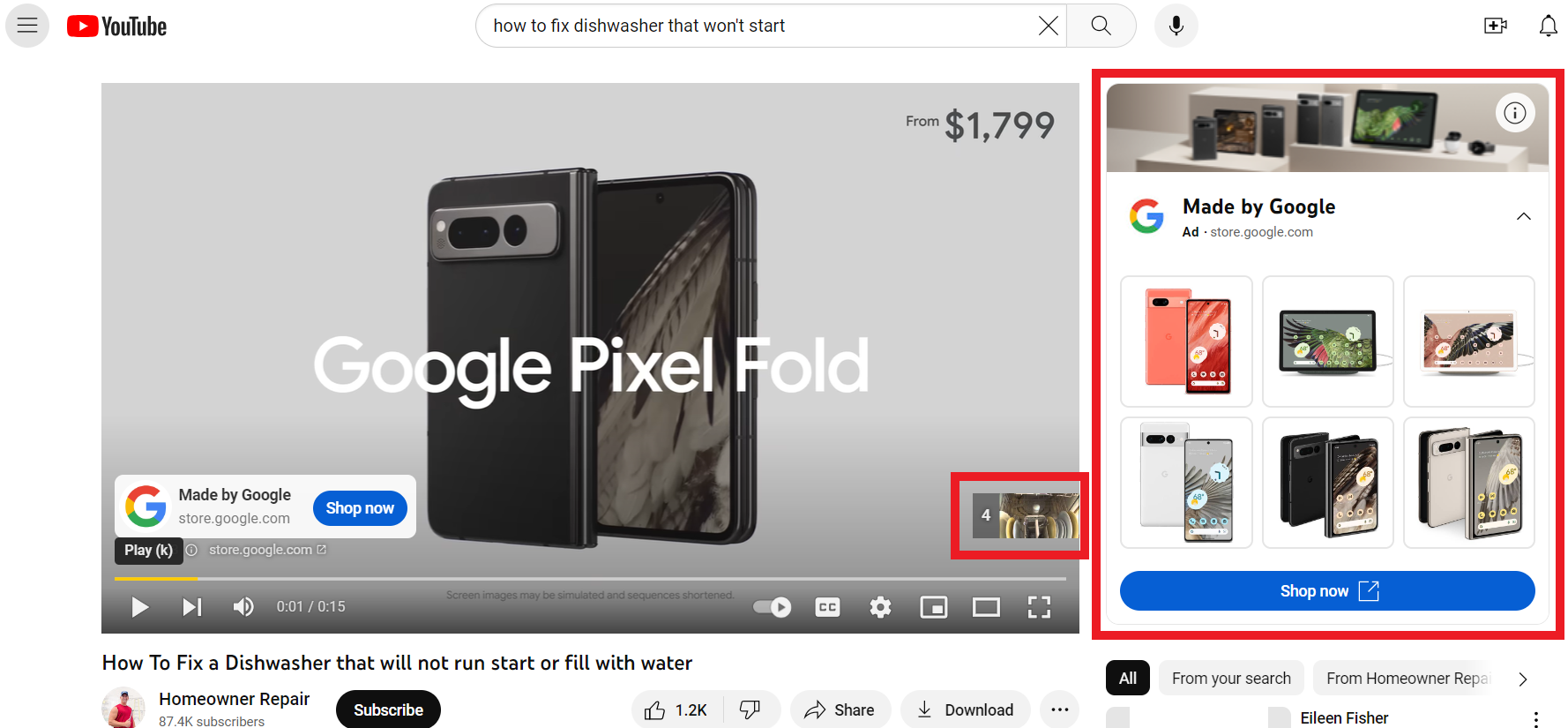 Screenshot from search for [how to fix dishwasher that won’t start], YouTube, September 2023
Screenshot from search for [how to fix dishwasher that won’t start], YouTube, September 2023In addition, the example also shows another ad by the same brand, taking up almost the whole real estate on the page.
App Campaigns
App campaigns let advertisers promote their app across most Google properties, including:
- Google Search.
- Google Play.
- YouTube.
- Gmail.
- Google Display Network.
Like other campaigns, the ad format and appearance will vary depending on the ad placement.
App install ads are comprised of the following assets:
- Headlines.
- Descriptions.
- Images.
- Videos.
- Assets from your app store’s listing.
Performance Max Campaigns
Performance Max campaigns all advertisers to access all of Google’s ad inventory in this single campaign type.
It’s a goal-based campaign intended to complement existing Search campaigns.
Per its name, Performance Max uses conversion signals to find and acquire new customers through all of Google’s channels, including:
- YouTube.
- Display.
- Search.
- Discover.
- Gmail.
- Maps.
The campaign uses other important signal inputs from the advertiser, such as audience signals, creative assets, data feeds, CPA or ROAS goals, and more.
The result?
A responsive ad format that can showcase to users in the form of:
- Search ad.
- Display ad.
- Video ad.
- Shopping ad.
- And more.
Demand Gen (Formerly Discovery) Campaigns
Demand Gen campaigns are Google’s newest campaign type, officially debuting in October 2023.
It’s powered by Google’s AI learning, meant to assist advertisers who already serve ads on social media platforms.
This campaign type focuses on creating compelling visual assets to spark action during entertainment touchpoints, including:
- YouTube (including Shorts).
- Discover.
- Gmail.
The ad assets combine a mixture of images and videos into one campaign. The resulting ad formats in Demand Gen campaigns include:
- Short-form videos.
- Carousel ads.
- Portrait images.
- Square images.
[Discover:] Expert insights & actionable tips for PPC in 2024
Google Ads Bidding Strategies
Choosing the proper bidding strategy in each Google Ads campaign is vital for optimal performance.
But in order to select the right one, you need to have a comprehensive understanding of larger business goals and other metrics.
Before selecting a bidding strategy, seek out the answer to some of these questions:
- What does the company view as success? Is it a specific ROAS, CPA, or conversion rate?
- What is the average lifetime value (LTV) of a user?
- What is the typical cost per acquisition (CPA) for a new user?
- Does a user purchase just once? Or are most customers repeat purchasers?
Obviously, there’s much more that can be uncovered to gain a better view of the company’s overall goals.
When it comes to selecting a bidding strategy in Google Ads, choose one that aligns most with that particular campaign goal:
- Conversions.
- Traffic.
- Visibility.
Let’s take a look at the available bidding strategies within these three major goal types.
Conversion-Based Bidding
For any campaign that uses conversion tracking or relies heavily on purchases, a Smart Bidding strategy is your best bet.
Smart Bidding is a set of automated bid strategies that use Google machine learning (AI). It optimizes each individual auction in “real-time” and adjusts bids according to a wide range of campaign signals.
There are five Smart Bidding strategies to choose from:
- Target cost per action (CPA). Helps increase conversion value while optimizing for a specific cost per action (CPA) set at the campaign level.
- Target return on ad spend (ROAS). Helps increase conversion value while optimizing for a specific return on ad spend (ROAS) set at the campaign level.
- Maximize Conversions. Ensures the entire budget is spent while optimizing for more conversion volume. This bid strategy isn’t constrained by a CPA or ROAS target.
- Maximize Conversion Value. Ensures the entire budget is spent while optimizing for more conversion value. This bid strategy isn’t constrained by a CPA or ROAS target.
- Enhanced cost per click (ECPC). An optional feature that can be used with Manual CPC bidding. Automatically adjusts manual bids to increase conversion volume.
Traffic-Based Bidding
If a campaign’s primary goal is to generate website traffic, choose from one of these two CPC bidding strategies.
- Maximize clicks. An automated bid strategy where Google automatically manages bids while bringing the most clicks possible for your budget.
- Manual CPC bidding. Advertisers manage CPC bids manually. Bids can be set at the ad group, keyword, or placement level.
Visibility-Based bidding
There are four different bid strategies to choose from if the goal is brand awareness or visibility.
- Target Impression Share. Bids are set automatically based on the particular goal of showing an ad at the absolute top of the page, top of the page, or anywhere on the Google SERP.
- CPM. Also known as “cost per mille” (cost per thousand impressions). Ads are charged based on the number of impressions received on the Google Display Network or YouTube.
- tCPM. Also known as “target CPM” bidding. Advertisers set an average of how much they’re willing to pay per thousand impressions. Bids are optimized to increase unique reach.
- vCPM. A manual bidding strategy to use if the goal is increased awareness and not focused on clicks or traffic.
Google Ads Conversion Tracking
You’ve spent all this time learning about setting up Google Ads campaigns.
Now it’s time to learn about how to actually track campaign performance.
If you jump straight into launching a campaign without proper tracking in place, your efforts may as well go to waste.
Ensuring proper conversion tracking setup from the start is a necessary part of the Google Ads process.
Conversion tracking allows you to analyze your data to make more informed optimizations to achieve your goals.
Convinced yet?
Good!
Let’s go over two ways to go about conversion tracking for Google Ads.
Using Google Analytics Tracking
Assuming you already have a Google Analytics account and are tracking website performance, the first step is to link those accounts.
By linking Google Analytics and Google Ads, you’ll be able to do things like:
- Integrate campaign click and cost data to Google Analytics conversion data.
- Import necessary conversions in Google Ads for conversion tracking and bid strategies.
- Analyze paths to conversion with other marketing channels.
- And so much more.
To link your Google Analytics account, go to Tools & Settings > Setup > Linked Accounts.
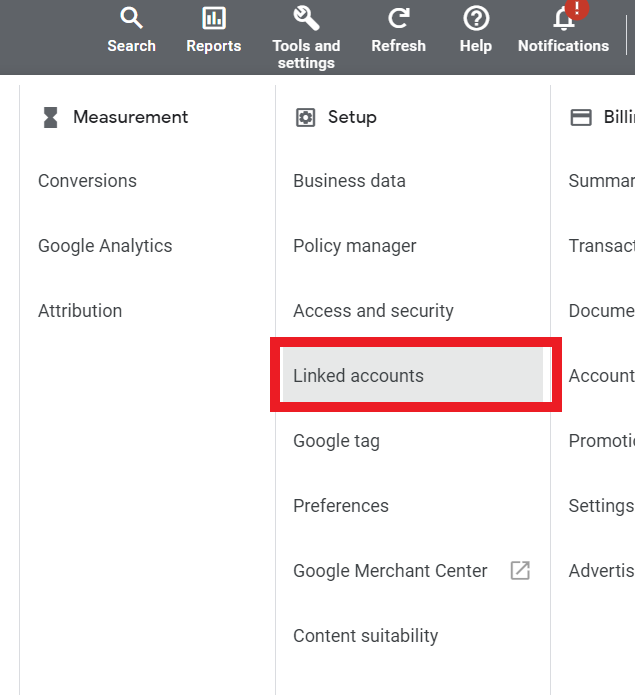 Screenshot from Google Analytics, September 2023
Screenshot from Google Analytics, September 2023From there, you’ll be able to choose from dozens of accounts to link based on your needs. You can link accounts in these categories:
- Conversions.
- Apps.
- Customer Match.
- Lead Export.
- Store Sales.
To link Google Analytics, you’ll need to make sure you have access to that particular Google Analytics account and property.
Select the property (or properties) to link and save.
Once linked, you’re able to import conversions set up in the chosen Google Analytics property and start measuring conversions!
Google Tag Tracking
If you aren’t using Google Analytics, another way to set up conversion tracking is through the Google tag.
It’s important to note that you don’t need the Google tag and a separate Google Analytics tag. Only one setup is necessary.
Having multiple tags can be detrimental because you run the risk of duplicating conversion counts, which essentially gives Google false data to optimize bidding strategies for.
So, implement the Google tag if you’re not using any other conversion tracking methods.
Google has made it easier for marketers to implement the Google tag.
The Google tag can be installed using a website builder or CMS like Wix, Shopify, etc., or it can be installed manually.
The full tutorial on installing the Google tag can be found here.
Once installed, you can create Conversion Actions to track primary conversions like purchases, demo requests, etc., as well as secondary conversions like email signups etc.
At the end of the day, choose the method for conversion tracking that makes the most sense for your business.
Without proper conversion tracking, it’s not possible to fully optimize Google Ads campaigns, and it will be harder to achieve those goals.
How To Get Started With Google Ads
Hopefully, this guide has convinced you to try out Google Ads.
Getting started is relatively simple and requires a few steps in order to craft your first campaign.
#1: Set up A Google Ads Account
Navigate to ads.google.com to set up your account. In the upper right-hand corner, choose Sign in or Start now.
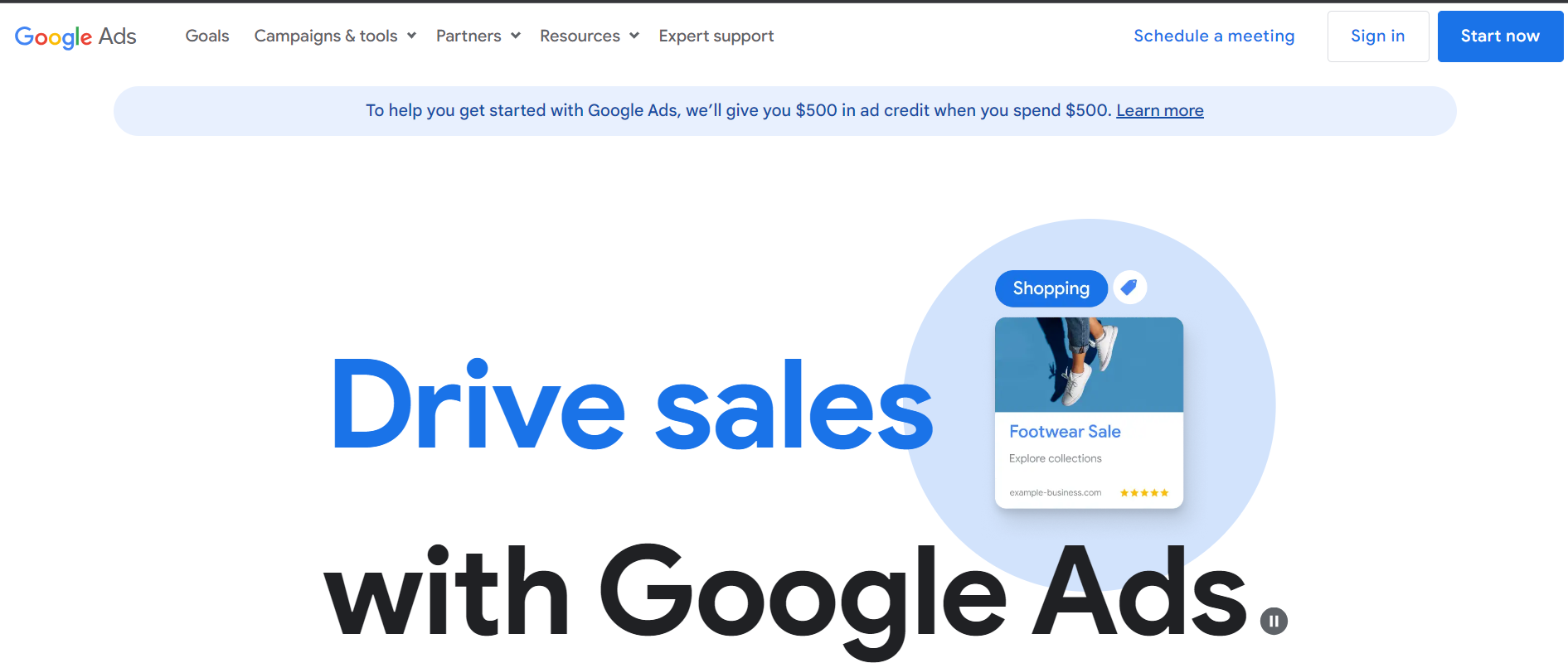 Screenshot from Google Ads, September 2023
Screenshot from Google Ads, September 2023If you have a current Google account you want to use, you can click Sign in. If you don’t have a Google account, it will prompt you to create a new one.
#2: Add Business Name And website
Next, you’ll need to add your business name (how you want the Google Ads account to be named) and your website URL.
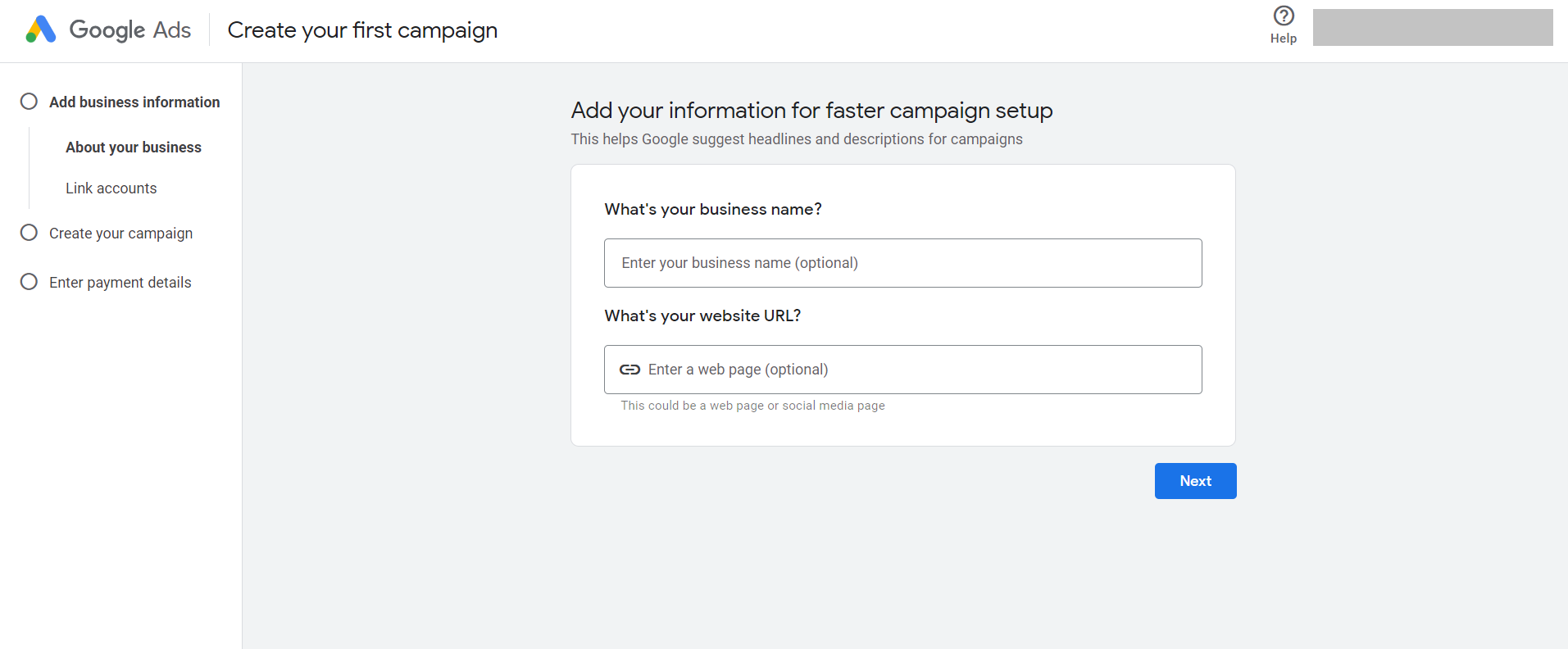 Screenshot from Google Ads, September 2023
Screenshot from Google Ads, September 2023#3: Link Accounts (Optional)
As mentioned in the conversion tracking section, you have the option to link any necessary accounts to Google Ads at the very start.
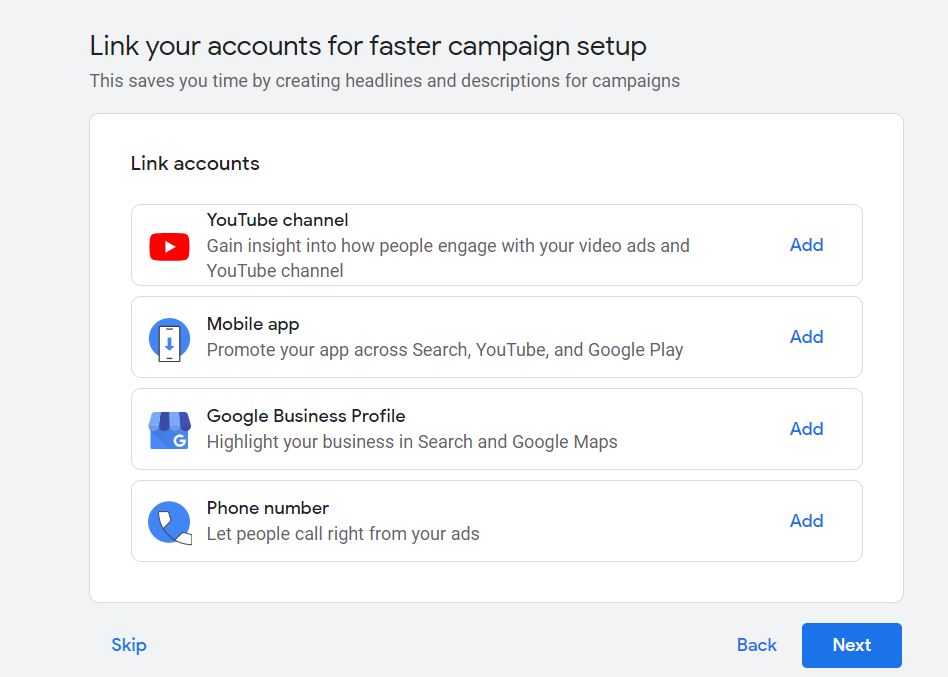 Screenshot from Google Ads, September 2023
Screenshot from Google Ads, September 2023If you’re not ready to do that yet, don’t fret! You’re able to link accounts at any time under the “Setup” tab later on.
#4: Choose Advertising Goal
Now it’s time to choose the primary advertising goal.
You can choose from four main goal types:
- Get more calls.
- Get more website sales or leads.
- Get more visits to your physical location.
- Get more views and engagement on YouTube.
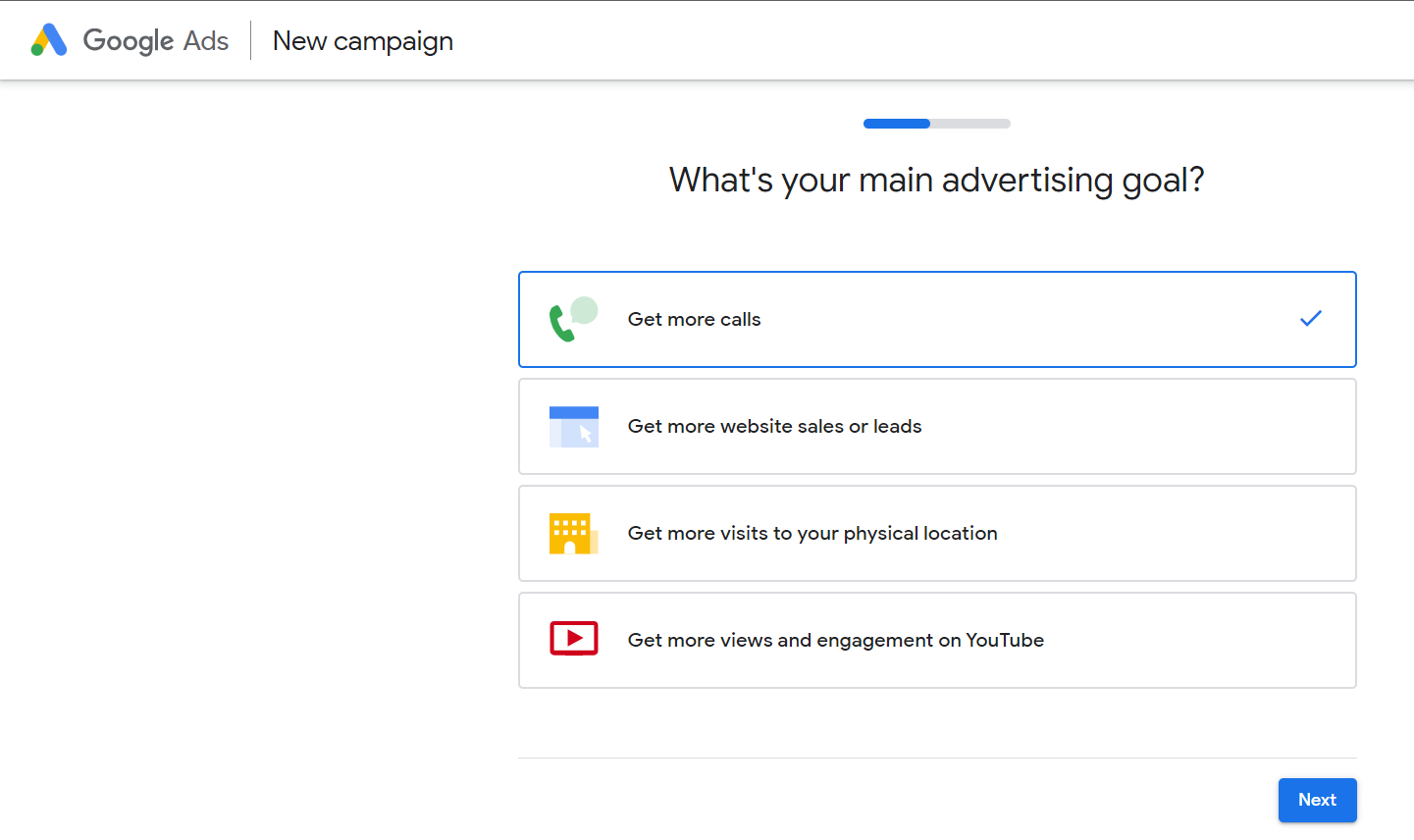 Screenshot from Google Ads, September 2023
Screenshot from Google Ads, September 2023Hit “Next” once you’ve chosen the most relevant goal.
#5: Write Your Ad (Option A)
The next logical step, according to Google, is to craft your ad.
At this point, your screen will look like this to craft your first ad:
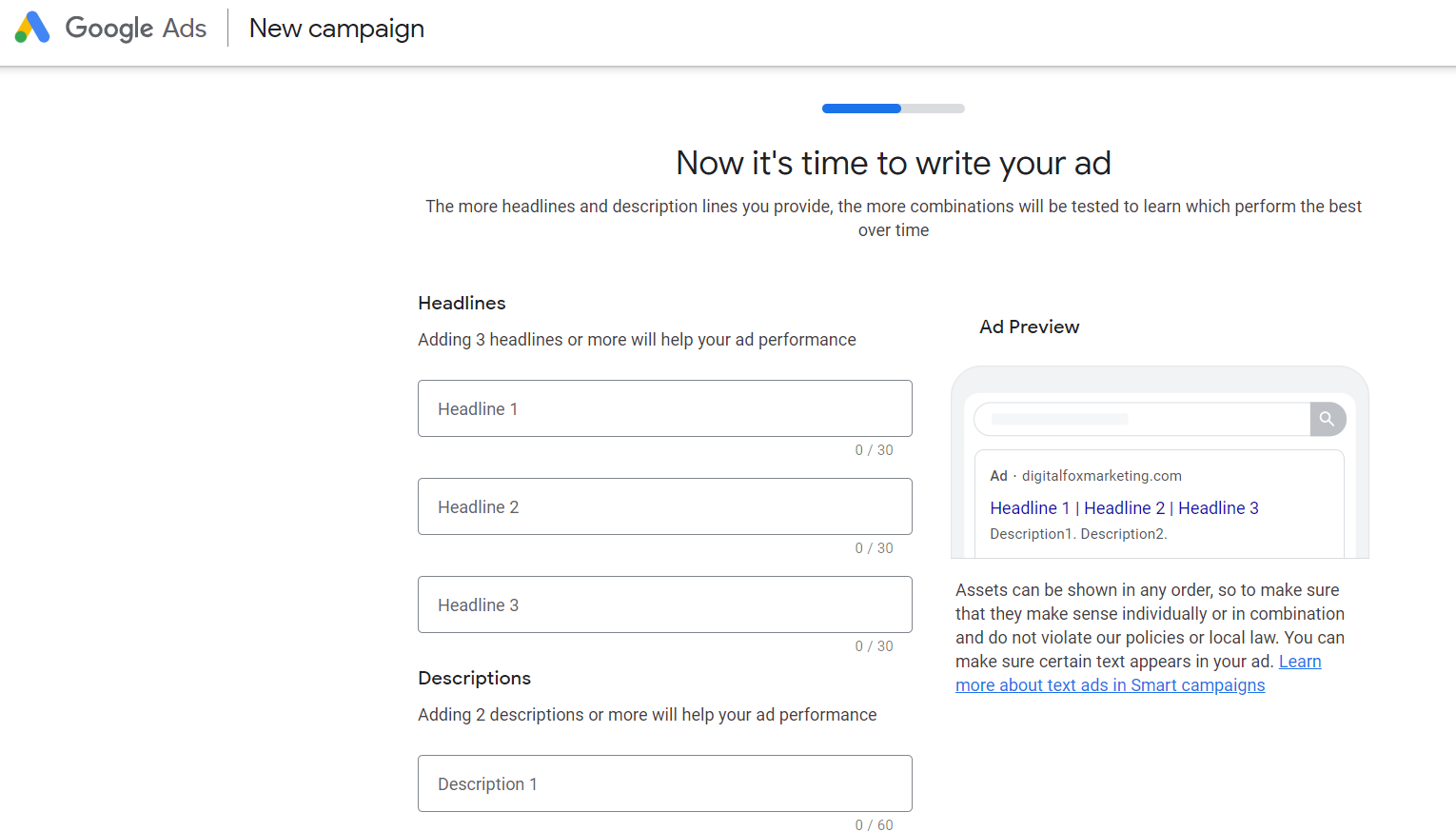 Screenshot from Google Ads, September 2023
Screenshot from Google Ads, September 2023Part of Google’s version of ‘getting started’ automatically puts you in the flow of creating a “Smart” campaign.
This campaign type is designed to take the “heavy lifting” away from many marketers and let Google do the rest.
Essentially, you’ll create your first ad consisting of headlines and descriptions and then pick your keyword themes.
If creating your first campaign from scratch seems daunting and time-intensive, then this step may be for you. And that’s OK!
But if you’ve made it this far in the ultimate Google Ads guide, there’s another not-so-known route.
#5: Create Your Campaign From Scratch (Option B)
If you’re looking for a bit more control in setting up your Google Ads campaign, this step #5 is for you.
Instead of choosing your objective in step 4, click View more goal types:
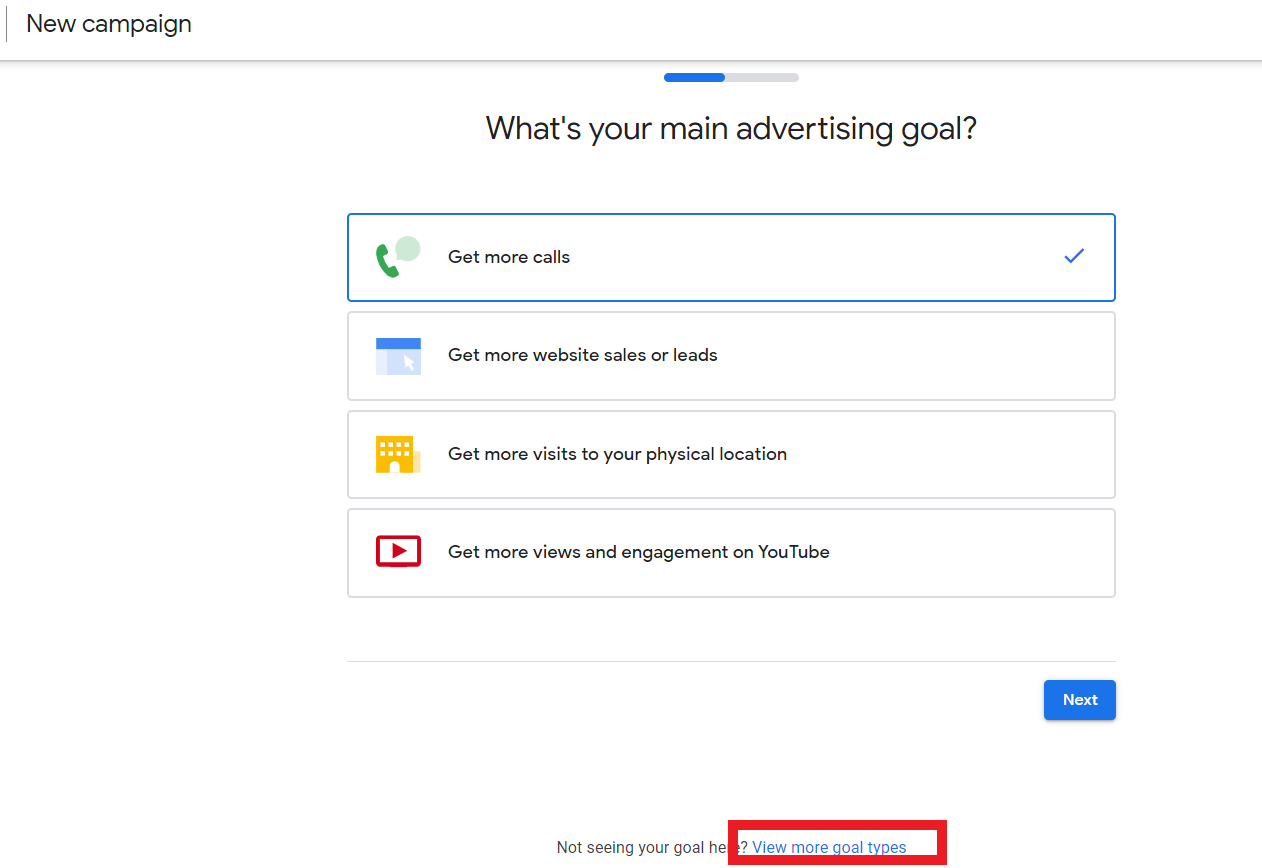 Screenshot from Google Ads, September 2023
Screenshot from Google Ads, September 2023You’ll be taken back to this screen, where you can click the down arrow next to Skip and then click Leave Campaign Creation.
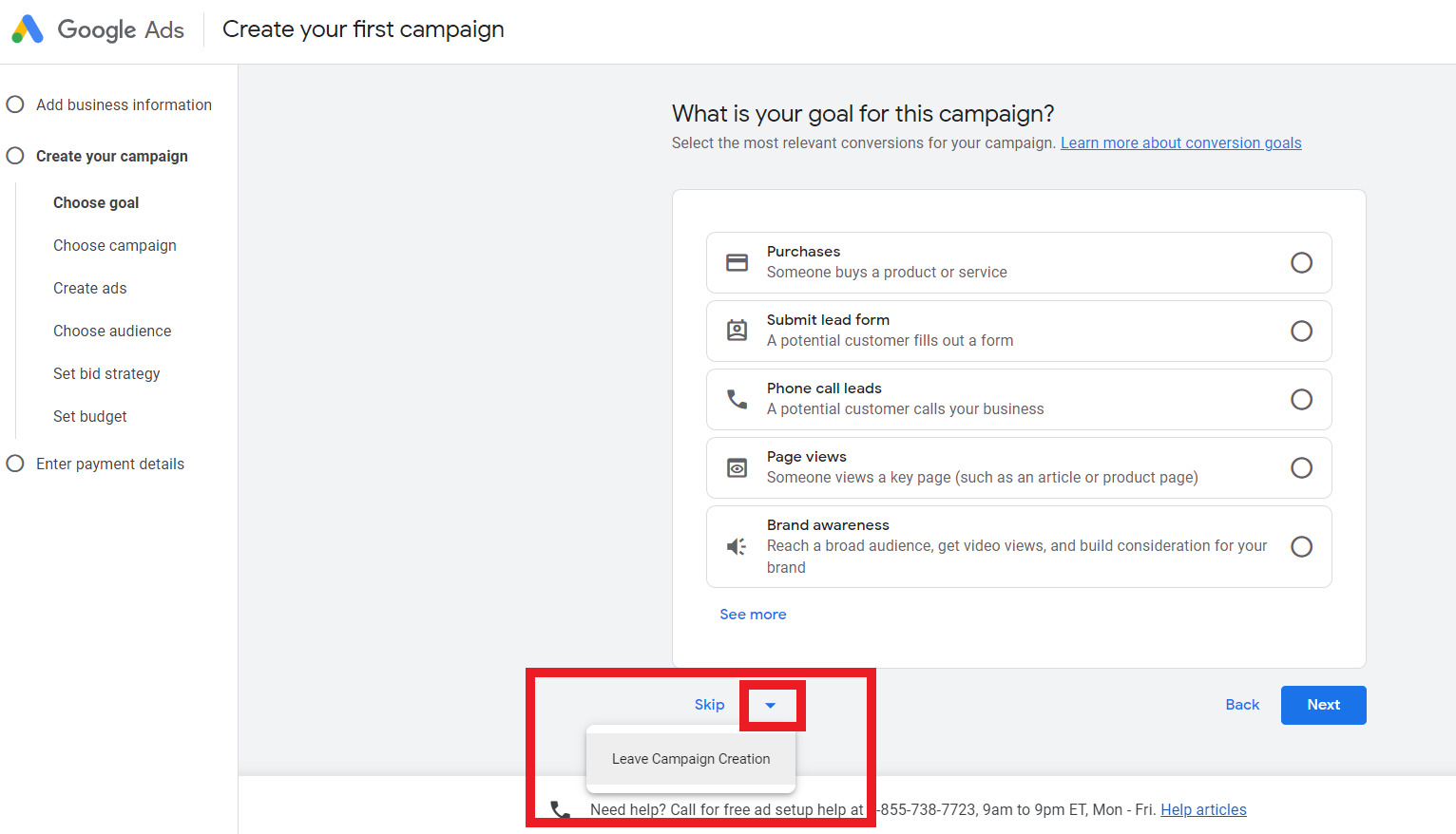 Screenshot from Google Ads, September 2023
Screenshot from Google Ads, September 2023#6: Input Billing Information
After exiting campaign creation, you’ll be prompted to input billing information. This is the final step before being able to craft your desired campaign type from scratch.
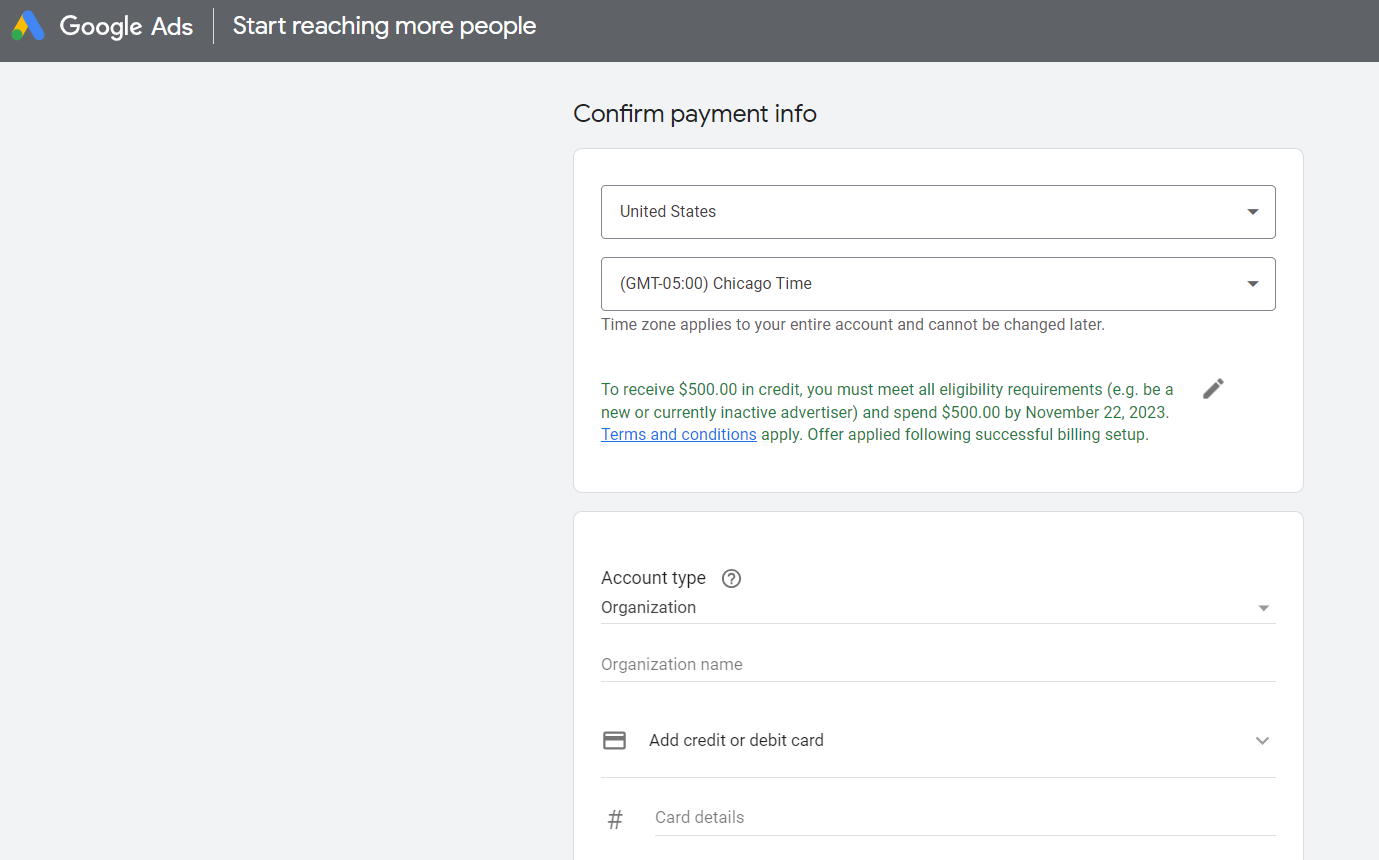 Screenshot from Google Ads, September 2023
Screenshot from Google Ads, September 2023As you can see, the initial steps to get started with Google Ads are relatively simple.
It’s important to remember that you have options when setting up an account for the first time.
While Google guides marketers to their first Smart campaign creation, it may not always be the best option – especially for seasoned marketers.
[Free Download:] Top PPC trends to shape your 2024 strategy
Google Ads Best Practices
There is a wealth of information on Google Ads best practices; it’d be impossible to sum it all up here!
Best practices are meant to be guidance – not the “end all be all.” They will vary by things like:
- Campaign type.
- Audience.
- Budget.
- And more.
However, there are some universal best practices to be aware of when launching any Google Ads campaign.
Keep User Intent In Mind With Ad Copy
If your ad copy doesn’t mirror a user’s search query or even their search intent, you’ll likely end up with a lower CTR.
Or worse, a user clicks on an ad when they’re not the right audience, wasting those precious ad dollars.
By keeping keywords grouped by theme, it’s easier to craft ad copy to mirror a search query or, at the very least, relate to that user’s search intent.
Keeping ad headlines relevant to the user’s search query is important to keep a good Quality Score and Ad Rank.
Those metrics help keep your competitive CPC in line so you don’t overspend that ad budget.
By using multiple headlines with Responsive Search ads, you have the opportunity to test out different messaging directly related to a user’s search query to find out what resonates the most.
Maximize Ad Space On The Google SERP
Speaking of ad copy, don’t forget about those ad assets!
By adding relevant ad assets such as sitelinks, lead forms, phone number, and more, your ad can take up more real estate on the Google Search results page.
Why does that matter?
By taking up more ad space on the page, it provides less opportunity for competitor content to show.
The more ad space you take up, the more likely the user is to click on your ad or corresponding asset.
Which can ultimately lead to more conversions and revenue.
Create A Stellar Landing Page Experience
A good ad is nothing without a strong landing page experience.
If your ad is promising a solution to a user’s problem, then that landing page better deliver on that promise.
Not only should the landing page content mirror the ad copy, but it should also be optimized to function as best it can.
What does that mean?
At the very least, ensure the site speed is optimized, especially on mobile devices.
Additionally, make sure the desired call-to-action (CTA) is clear and visible to the user.
If the experience is confusing to them, it’s going to take some extra effort (and possibly marketing dollars) to convert – especially if they leave the site without purchasing.
Have A Negative Keyword Strategy
As keyword match types continue to loosen within Google Ads, make sure to have a solid negative keyword strategy.
By using negative keywords correctly, you’re ensuring that your ads won’t be shown for irrelevant search queries.
If there are certain queries you know you don’t want to show up for at any time, start by creating a “catch-all” negative keyword list and apply it to the account level.
Another good list to have in place is branded keywords, and apply them to any non-brand Search campaigns.
This ensures little-to-no overlap between brand and non-brand searches, as these campaigns perform very differently from each other.
Mining for negative keywords should be done weekly when reviewing the Search Terms Report in Google Ads.
Negative keywords are never a “one-and-done” tactic, as user search intent is ever-evolving.
Summary
Google Ads should be an integral part of any paid media strategy.
This ultimate guide to Google Ads gives you the tips, tools, and resources you need to start a successful journey with Google Ads.
Remember – success is in the settings. Creating a sound Google Ads strategy comes from the understanding of larger business goals, as well as knowing the intricacies of the Google Ads platform.
Once you’ve launched your first Google Ads campaign, remember to analyze, refine, and optimize to achieve your goals.
More resources:
- PPC 101: A Complete Guide to PPC Marketing Basics
- 15 Ways to Optimize a Paid Search Campaign
- PPC Trends 2023
Featured Image: BestForBest/Shutterstock

